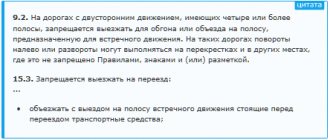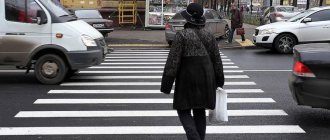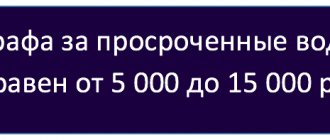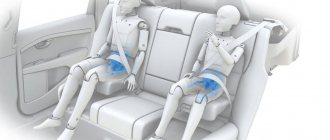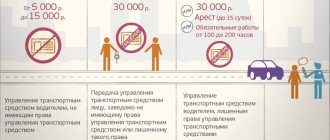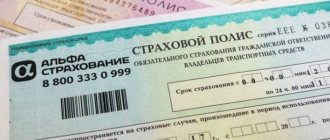Good afternoon, dear reader.
This article will talk about double solid marking lines , as well as penalties for crossing such markings in various situations.
Double continuous markings always separate traffic flows in opposite directions. That is, a car driving to the left of a double solid line is in the oncoming lane. And for such a violation, the legislation provides for quite serious penalties, including deprivation of rights.
In what cases can you cross a double line?
Let's turn to Appendix 2 to the traffic rules:
1.3 - separates traffic flows in opposite directions on roads with four or more lanes for traffic in both directions, with two or three lanes - with a lane width of more than 3.75 m;
... Lines 1.1, 1.2 and 1.3 are prohibited from crossing.
That is, if we are talking about an ordinary driver of an ordinary car, then he cannot cross .
However, you need to remember that there are several exceptions to the rules in which the markings can be crossed without violation:
- at the signal of the traffic controller;
- if there is a yellow or orange flashing light on (when performing road work, evacuating cars or transporting large cargo);
- when the blue flashing light is turned on.
Types of solid lines according to traffic rules
According to traffic rules and GOST 51256-2011, solid lines are divided into several types:
- Single (or line 1.1) - like a broken line, divides the roadway into two differently directed flows, but its main function is to mark especially dangerous sections of the highway, where any departure into the oncoming lane can be fatal;
- Single (1.2) – slightly wider than lane 1.1 and marks the boundaries of the roadway on both sides of the highway;
- Double (1.3) – also divides the route into equal halves, but is applied exclusively to roads where cars move in four streams or more;
- The yellow line (1.4) is the least common and indicates places on the edges of the roadway where stopping cars is prohibited.
There are also yellow and orange lines. They are used to mark out new detour routes during road works. They are temporary and will also have to be followed.
All of the listed types of continuous markings are strictly prohibited from crossing unless you have special reasons for this, which we will talk about in the appropriate paragraph. There is a fine for flouting the rules.
What is the difference between one solid and double?
From the point of view of traffic rules, single and double solid marking lines are not very different from each other. None of these lines can be crossed .
Nevertheless, they still have a difference. Single continuous markings can separate both oncoming and passing lanes on the road. While a double solid line always separates only oncoming lanes. That is, a car that is to the left of the double solid marking line is guaranteed to be in the oncoming lane.
What does yellow double solid mean?
The yellow double solid marking line is not provided for either by the traffic rules or by GOSTs, to which traffic regulations refer. As a rule, when talking about yellow double solid, drivers mean orange markings.
Orange markings are temporary and take precedence over permanent (white) markings. That is, if there are both white and orange marking lines on the road and they contradict each other, then you should be guided by the orange lines.
Temporary road markings
Controversial situations
Controversial situations on the road can arise even with the most correct and attentive drivers. For example, in winter, road markings may simply not be visible under a layer of fallen snow. If a motorist does not know that there is a prohibitory marking in the place chosen for a U-turn or turn, he may not notice it. In other situations (this happens especially often in the spring), the applied continuous stripes are simply erased from the road surface.
It is the poor quality of the markings and its non-compliance with the requirements of GOST R 51256-2011 that can be referred to if you are detained by an inspector. For example, a DVR recording can serve as proof of your words.
It is best to record the current traffic situation with a mobile phone camera so that your car with clearly readable license plates is included in the frame along with the road.
If you believe that the inspector was wrong in issuing a fine for violating marking rules, you can challenge his decision within 10 days from the date of imposing the penalty. To do this, you will need to contact the court or the head of the regional traffic police department.
Do cameras record the intersection of a double solid line?
In 2021, automatic cameras that record violations of traffic rules can also record driving into the oncoming lane and crossing any marking line.
It is possible that not all automatic fixation systems have such a function. However, if the driver crossed a double line directly under the camera, then there is a high probability of subsequently receiving a fine.
What violations are recorded by traffic police cameras?
Exceptions to the rules
Crossing or hitting a double solid road is not punishable by traffic rules if:
- The maneuver was caused by extreme necessity; the driver in a risky situation could not do otherwise. Such actions are considered justified if the actual damage has become less than the prevented damage.
- Lack of markings in the correct place or their poor condition. In this case, the driver will have to prove that he did not know about the violation of the rules. Photos from the scene or dashcam footage may be useful in court.
Penalty for double solid
The punishment for crossing the markings is described in Part 1 of Article 12.16 of the Code of Administrative Offences:
1. Failure to comply with the requirements prescribed by road signs or markings of the roadway, with the exception of cases provided for in parts 2 - 7 of this article and other articles of this chapter, -
entails a warning or the imposition of an administrative fine in the amount of five hundred rubles.
It should be understood that this punishment will be imposed only if the driver’s actions do not fall under other articles of the Administrative Code.
That is, if a driver drives straight and crosses a double solid marking drawn perpendicular to the direction of travel, then he will face a fine of 500 rubles or a warning .
The punishment for crossing the markings when turning left or making a U-turn is described in Part 2 of Article 12.16 of the Administrative Code:
2. Turning left or making a U-turn in violation of the requirements prescribed by road signs or markings of the roadway -
shall entail the imposition of an administrative fine in the amount of one thousand to one thousand five hundred rubles.
Crossing a double continuous line when turning left or making a U-turn is punished more seriously - with a fine of 1,000 - 1,500 rubles .
The punishment for crossing a double solid line while avoiding an obstacle is described in Part 3 of Article 12.15 of the Code of Administrative Offenses:
3. Driving, in violation of the Traffic Rules, into a lane intended for oncoming traffic when going around an obstacle, or onto tram tracks in the opposite direction when going around an obstacle -
shall entail the imposition of an administrative fine in the amount of one thousand to one thousand five hundred rubles.
The fine in this case also ranges from 1,000 to 1,500 rubles .
Checking and paying traffic fines 10% discount
The fine for crossing solid markings depends on the qualifications of the driver’s action. Therefore, the amounts of penalties vary significantly and range from 500 rubles to 5000 rubles .
However, the specified amount of the penalty can be reduced if it is paid within 20 days from the date of drawing up the protocol. Thus, according to the law, the driver is given 10 days to make a decision to appeal the decision to impose a penalty and another 30 days to voluntarily pay the fine.
If a person pays fines for crossing a solid line within 20 days, then he receives a 50% discount. For example, if a claim is made in the amount of 100 rubles, you will only need to pay 500 rubles.
To save money, you need to find out information about the presence of fines. You can obtain such information on the State Traffic Safety Inspectorate website, as well as on the unified State Services portal.
Deprivation of rights for double continuous
The most serious punishment is provided for crossing a double solid line, as a result of which the car ended up in the oncoming lane, but the car does not take a detour. Parts 4 and 5 of Article 12.16 of the Administrative Code:
4. Driving, in violation of the Traffic Rules, onto a lane intended for oncoming traffic, or onto tram tracks in the opposite direction, except for the cases provided for in Part 3 of this article -
shall entail the imposition of an administrative fine in the amount of five thousand rubles or deprivation of the right to drive vehicles for a period of four to six months.
5. Repeated commission of an administrative offense provided for in Part 4 of this article -
entails deprivation of the right to drive vehicles for a period of one year, and in the event of an administrative offense being recorded by special technical means operating in automatic mode, having the functions of photography, filming, video recording, or means of photography, filming, video recording - the imposition of an administrative fine in the amount of five thousand rubles
For the first violation, you can receive a fine of 5,000 rubles or deprivation of rights for 4-6 months . Repeated violation will result in deprivation of rights for 1 year or a fine of 5,000 rubles.
Such a penalty can be imposed, for example, for overtaking through a double solid road or for driving around a traffic jam that is not an obstacle in the oncoming direction.
○ Recording cameras.
Since 2008, technical means, including photo and video cameras, have been used to record traffic violations (including driving through double lanes).
Current regulations require cameras to meet the following conditions:
- They were certified, verified and calibrated. If there are no documents confirming the verification of a particular camera, its use is not allowed, and the evidence obtained with its help cannot be used when making a decision in an administrative case. Initially, traffic police inspectors tried to use household video cameras, but now this is absolutely unacceptable: only specialized complexes for video and photography that have passed the approval procedure can be used.
- They must record not only the fact of the offense, but also the model of the vehicle, and most importantly, the license plate number. Without this, there is no way to prove that a specific driver committed the offense.
Now, in order to record the intersection of a double solid line, two types of cameras are used:
- Mobile devices mounted on traffic police patrol cars, or installed manually on the highway and controlled from the nearest traffic police post.
- Stationary, pole-mounted, viaduct posts and other high-rise objects located along a street or highway.
Currently, services that monitor order on the road are armed with many different types of cameras. They differ in terms of use (for example, the Arena complex can work in the dark, while Rapier usually at night, in fog and during rain gives unreliable results), capabilities (modern complexes, for example, have the function shooting in the infrared range), image quality and other technical details. However, no matter what camera is used, usually the very fact of its use means that it has passed technical approval, verification and licensing.
Table of penalties for crossing double solid markings
| Article of the Administrative Code | Intersection of double solid | Punishment |
| 12.16 p.1 | without the actions listed below | warning or 500 rubles |
| 12.16 p.2 | when turning left or making a U-turn | 1,000 - 1,500 rubles |
| 12.15 p.3 | with driving into oncoming traffic when going around an obstacle | 1,000 - 1,500 rubles |
| 12.15 p.4 | with oncoming traffic in other cases | 5,000 rubles or deprivation of rights for a period of 4 to 6 months |
| 12.15 p.5 | repeated departure to the oncoming traffic in other cases | deprivation of rights for 1 year (5,000 rubles if the violation is recorded by cameras) |
Lawyer's advice on how to prove innocence
When a violation is recorded on camera, there is no point in proving anything. The only option is to prove that the camera was unreasonably installed in the appropriate location or that it was not operating properly. To do this, you will need to go to court through administrative proceedings and request a document on the technical condition of the equipment and the validity of its installation.
When drawing up a protocol, the traffic police officer must carefully check this document. Any errors, for example, in the place, date, driver details, etc., may cause the decision to impose a fine to be canceled.
Penalty for turning left
In this case, punishment can be imposed under Part 2 of Article 12.16 of the Administrative Code - 1,000 - 1,500 rubles .
It is important to understand that we are talking specifically about turning left. If before turning the driver drives even a little in the oncoming lane, the punishment will be different - 5,000 rubles or deprivation of rights for 4 - 6 months.
Punishment for detour
The figure above shows an obstacle (open hatches), for avoiding oncoming traffic a fine of 1,000 to 1,500 rubles .
It is important to understand that a vehicle that has stopped moving without violating the rules is not an obstacle:
For driving around a bus that is waiting in line to stop, punishment will be imposed under Part 4 of Article 12.15 of the Administrative Code - deprivation of rights for 4-6 months or a fine of 5,000 rubles.
Where is it prohibited to overtake according to traffic rules and what is the responsibility?
So, we have come to the most extensive question of our topic. As we said above, there are a lot of conditions for prohibiting entry into the oncoming lane, and many of them sometimes have a fine line between permitted and prohibited overtaking.
But first of all, let's talk about the very concept of this term!
Overtaking or not?
This maneuver itself consists of 3 other maneuvers:
- changing lanes into oncoming traffic,
- directly ahead of the overtaken vehicle,
- returning to your lane in front of the overtaken person.
The very definition of the term “Overtaking” in paragraph 1.2 of the Rules speaks about the oncoming lane. Thus, changing lanes in the same direction and then overtaking is not considered overtaking, and therefore a fine or deprivation of rights is in no way applicable in this case. Likewise, advancing on the right or along the right shoulder cannot fall under this term.
We will return to these questions below.
Through a continuous line with an intersection
At the very beginning of the article, it was not for nothing that we talked about responsibility not specifically for overtaking as a whole set of 3 maneuvers, but specifically for the main one - moving in the opposite direction in cases where this is prohibited by traffic rules.
This is true, because in this case the Rules do not directly prohibit overtaking through a continuous lane. They prohibit crossing it - this is what clause 9.1(1) introduced after recent changes to the traffic rules says. But even before the introduction of new rules, drivers were still subject to fines and imprisonment. It’s just that the prohibition was not clearly stated in the Rules.
Expert opinion
Yuri Panchenko
Driving instructor, human rights activist, author of books. 10 years of experience.
When considering issues related to driving into oncoming traffic, it is important to know:
- Departure continues from the moment any part of the car appears in the oncoming lane until the moment the car completely leaves the oncoming lane. That is, departure is a long-term action. This is the opinion of the Constitutional Court.
- All cases of driving into oncoming traffic are considered in the Resolution of the Plenum of the Supreme Court No. 18 dated June 25, 2019. This includes all the cases described in the article.
I would like to draw your attention to one subtlety. If you turn left into the yard through a double solid lane, then the punishment under Part 1 of Article 12.16 of the Code of Administrative Offenses with a fine of 500 rubles. But if you leave the yard to the left through a double solid lane and after turning you find yourself in the extreme left lane, then the punishment is under Part 4 of Article 12.15 of the Administrative Code with a fine of 5,000 rubles or deprivation of the right to drive for a period of 4 to 6 months.
Ask a Question
If there was a double solid?
Please note that the above paragraph does not only refer to a single solid line marking which will result in a penalty for overtaking. This includes 2 more types of markup:
- 1.3 – double solid line (it separates oncoming traffic on roads with 4 or more lanes),
- 1.11 - solid with a dotted line, which prohibits crossing it only on one side - in this case, on your side.
What if you can’t see the solid one?
According to the Federal Law on Road Safety, responsibility for road maintenance falls on the state. At the same time, in order to ensure liability for such content, there is also a separate measure of liability for its violations.
Consequently, if the driver violated the marking requirement and crossed a solid line (including a double line) to overtake, then there should not be a fine for this, because it is not his fault. It is the fault of the authority responsible for this section of the road.
But this state of affairs is applicable only if the traffic police officer or judge examining the case does not know (including from the motorist himself) that the driver knew about the presence of a continuous road when overtaking or suspected its existence in a given place.
Is it possible to finish by crossing a solid line if you started through a broken line?
No. This is prohibited, and this is exactly how judicial practice works in 2021 for crossing a solid line when overtaking.
The fact is that the courts here do not at all recognize the absence of the driver’s guilt in the fact that he did not foresee the beginning of the solid line (since he did not notice the “Overtaking is prohibited” sign) for one reason or another.
But, again, it all depends on the specific circumstances of the case. For example, if the dashed line before the solid one did not first turn into a long dashed line, warning about the imminent start of the continuous marking (1.6), then the deprivation of license or the fine for overtaking has every chance of being cancelled, since the driver could not have foreseen the sudden appearance of line 1.1 or 1.3.
Subtlety with a continuous road without entering the oncoming lane
As we already wrote above, a fine is issued or a deprivation is assigned at 12.15 in the case of specifically driving into the oncoming direction of traffic. But what is the threat and what will be the amount of the fine if we are talking about crossing a continuous line while overtaking without oncoming traffic? Or if the plot unfolds on a one-way road.
Here, as we found out, the term “overtaking” is not applicable at all, since it is associated only with the oncoming lane.
In this case, marking 1.1 divides the lanes into passing directions. Namely, a continuous one was applied, because this is considered a dangerous section of the road. For example, a sharp turn or approaching an intersection.
And in this case, the fine will be much lower - 10 times than for crossing a solid marking line when overtaking, where the oncoming lane is located. Its amount is 500 rubles under Part 1 of Article 12.16 for violation of markings. It can also be paid with a 50% discount.
And according to the legislation of 2021, there should be no deprivation here.
Something else useful for you:
- How to drive through a roundabout intersection correctly according to the new rules? Sequence, stripes and signs
- What are the rules for road humps? Dimensions, installation and penalties
- Traffic regulations about passing a stationary car on a continuous road: what is the fine and is it possible to cross?
Under the “No Overtaking” sign
And again we return to the punishment specifically for driving into the oncoming lane. It does not matter which specific clause of the Rules prohibited overtaking - a sign, continuous markings or the presence of a pedestrian crossing. In any case, the punishment will follow precisely for prohibited driving into the oncoming lane. And it is the same - a fine of 5,000 rubles or imprisonment for a period of 4 to six months under Part 4 of Article 12.15 of the Administrative Code.
What if the sign wasn't visible?
Similar to snow-covered, dirty or erased solid markings, the absence of a “No Overtaking” sign, of course, entails the illegality of a fine or deprivation. But wait, why are we talking about the absence of a road sign?! After all, it is there, we just didn’t notice it - for example, when overtaking a long truck on the highway.
The thing is that GOST, which regulates the rules for installing road structures, has recently undergone changes. So, according to the new rules for installing signs - clause 5.1.6 of GOST R52289-2019, sign 3.20 Overtaking is prohibited must be duplicated on the left so that it is visible to all road users.
And we return to measures of responsibility. If 3.20 is not on the left, then, indeed, you are not subject to punishment, and the decision should be canceled. Moreover, in this case, the judge hearing the case is obliged to issue an order to the road services to eliminate this defect.
Of course, all of the above takes place only if in this section entering the oncoming lane was prohibited only by a sign. If there was a continuous marking visible to the eye, then, alas, it will not be possible to challenge the deprivation of rights on this basis.
What if the road sign is temporary?
It doesn’t matter whether the “No Overtaking” sign is permanent or temporary – the penalties for it are the same.
At a pedestrian crossing
Overtaking is prohibited. This is expressly stated in paragraph 11.4 of the traffic rules. At the same time, before crossings there should always be a continuous marking line separating oncoming traffic.
Please note that you can get ahead of other cars (that is, without entering oncoming traffic) only taking into account clause 14.2 - if another car has stopped or slowed down in front of a pedestrian crossing, then you must do this too.
At the crossroads
There are 2 important conditions when overtaking at intersections is allowed:
- if it is unregulated by traffic lights,
- if you are driving along the main road of an unequal intersection.
This is regulated by paragraph 11.4 of the traffic rules.
In all other cases, overtaking is prohibited.
When turning
Moreover, please note that even if the main road turns right or left, there is nothing that would prohibit you from overtaking straight ahead. However, when turning left, keep in mind the presence of paragraph 8.6 of the Rules, which indicates to press as far to the right as possible when turning right.
In addition, if, for example, the main road turns, and you need to go straight, then nothing here prohibits you from overtaking, since the intersection itself includes the main road along which you are moving - that is, you find yourself on a secondary road already at the exit from the intersection.
Double overtaking in a column
It is also forbidden to overtake another car, as this maneuver is also called a “locomotive”. Thus, clause 11.2 literally prescribes the following:
- overtaking is prohibited if the car in front has started it,
- it is also prohibited if someone from behind has entered the oncoming lane,
- and the third case - if the car ahead turns on the left turn signal.
At the railway crossing
Overtaking is prohibited on 2 sections of the road (clause 11.4):
- at the railway crossing itself,
- 100 meters in front of him.
Please note that there are also usually continuous markings at a sufficient distance to the crossing.
Moreover, the Code of Administrative Offenses of the Russian Federation has a separate article for all violations at crossings - 12.10. However, here Part 4 of Article 12.15 with deprivation or a fine will still apply, since this is a more special standard of liability specifically for overtaking at a railway crossing.
On right
In general, there is no such thing as overtaking on the right if you are in Russia, where right-hand traffic is organized.
As we have already indicated above, overtaking is certainly associated with driving into the oncoming lane. It cannot be on the right. And here, the maximum you can face is a fine of 500 rubles for a solid line separating passing lanes.
On the side of the road
...Well, or the amount of the fine increases to 1,500 rubles if you are ahead of a vehicle on the side of the road. You will be charged under Part 1 of Article 12.15 of the Code of Administrative Offenses of the Russian Federation.
We also have a special article about overtaking another car on the oncoming side of the road.
Overtaking a tram
There are nuances here too. Firstly, a tram cannot be overtaken under any circumstances, because you cannot move on oncoming tram tracks. But you can travel along tram tracks in the same direction, and also under 2 conditions:
- if they are located to your left,
- if they are not completely separated,
- if they are at the same height as the roadway (clause 9.6 of the traffic rules).
Punishment for crossing the road
The figure above shows a situation in which a driver can get away with a minimum punishment for crossing double solid markings - a warning or a fine of 500 rubles .
In this case, the car does not make a turn or turn and does not end up in the oncoming lane. He just drives straight through.
What does the punishment depend on?
There are several points that can reduce or increase the penalty.
- According to the law, responsibility is dictated by a specific clause of the Code of Administrative Offenses of the Russian Federation - some offenses are recognized as more serious and imply a greater chance of creating an emergency situation, and accordingly the sanction for crossing the markings will be greater.
- The traffic police inspector can independently choose the penalty. If he considers that a lighter punishment option is fair in this case, he will issue a fine in monetary terms, but if, in his opinion, your action could have caused an accident, he will take away your rights for a period that is also given to him for consideration.
It may happen that the driver gets off with a warning altogether - the employee decided that there was no serious violation of the rules. Situations on the roads vary greatly, and it is difficult to predict his reaction.
- When it comes to cameras, they issue maximum fines, and this is not always fair. Read about them below.
Punishment for collision
Unlike broken marking lines, which are allowed to be driven over only when changing lanes (Section 9.7 of the Traffic Regulations), the rules do not prohibit driving over double continuous markings. only forbidden . That is, if a driver accidentally hits a marking with his wheel, but does not cross it (does not hit the oncoming lane), then he should not be punished.
In conclusion, I would like to remind you once again that a double solid marking line always separates the oncoming lane . That is, the main incentive not to cross these markings is not a possible punishment from the traffic police, but a high probability of getting into a serious accident with an oncoming car. In general, first of all, be careful.
Good luck on the roads!
Will I be given a deprivation or a fine?
This depends on a number of factors, and this issue is regulated by the same Administrative Code. Although, there are other conditionally unwritten conditions for assigning one or another sanction.
- First, to receive a fine, you must have the maximum number of mitigating conditions for a given violation.
- Secondly, there should be no aggravating factors, such as repeated violation, state of intoxication and others.
- Thirdly, you should not have any fines for the last year, not unpaid, but in general. This comes from subparagraph 2 of paragraph 1 of Article 4.3 of the Code, which refers to the presence of homogeneous violations as an aggravating circumstance. Alas, almost all drivers in Russia do not meet this condition. And this was decided by the Supreme Court, which indicated that the homogeneity of the offense applies to all road traffic - that is, the presence of any decisions over the last year is considered an aggravating factor.
